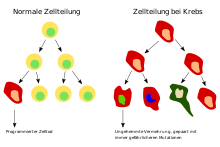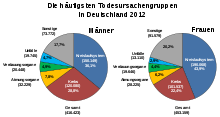Cancer
![]()
Crab disease is a redirect to this article. For the animal disease, see Crayfish plague.
In medicine, cancer refers to the uncontrolled proliferation and proliferating growth of cells, i.e. a malignant tissue neoplasm or malignant tumour (malignant tumour, malignoma). Malignant means that, in addition to cell proliferation, there is also deposition (metastasis) and invasion of healthy tissue. In the narrower sense, malignant epithelial tumors (carcinomas), then also malignant mesenchymal tumors (sarcomas) are meant. In a broader sense, the malignant hemoblastoses are also referred to as cancer, such as leukemia as "blood cancer".
All other tumors, which also include benign neoplasms, are not called cancer in modern medicine. These are proliferations of tissue or space in the body that do not form metastases. This applies both to the swelling caused by inflammation and to benign neoplasms (new formations of body tissue caused by misregulation of cell growth).
Benign tumours such as moles and fatty growths (lipomas) are not referred to as cancer in technical language, but they can still become dangerous because they can degenerate or impair the function of vital organs (such as the cerebellopontine tumour). Cancer, in common usage, is a catch-all term for a variety of related diseases in which body cells can grow uncontrollably, divide, and displace and destroy healthy tissue. This phenomenon is, according to current knowledge, limited to placental mammals, provided that the hemoblastoses are disregarded. Cancer has different triggers, all of which ultimately lead to a disruption of the genetically regulated balance between cell cycle (growth and division) and cell death (apoptosis).
The medical discipline dedicated to cancer is oncology.
.jpg)
Breast cancer cell under a scanning electron microscope
Occurrence and course
| Standardized incidence (new cases)/100,000 population (European standard) | ||||
| Art | Incidence | 5-year survival rate | ||
| ♀ | ♂ | Current | 1980s | |
| Total | 348,3 | 422,9 | ♀:65; ♂:59 | ♀:50–53; ♂:38–40 |
| in children | 17 | approx. 85 | approx. 67 | |
| Oral cavity and pharynx | 6,5 | 17,6 | ♀:58–68; ♂:42–50 | |
| Esophagus | 2,4 | 9,4 | ♀:11–36; ♂:14–31 | <10 |
| Stomach | 7,2 | 14,8 | ♀:29–40; ♂:24–42 | |
| Intestine | 31,8 | 50,7 | ♀:60–66; ♂:58–66 | approx. 50 |
| Pancreas | 10,4 | 14,4 | ♀:4–19; ♂:5–14 | |
| Larynx | 0,8 | 5,4 | ♀:63; ♂:50–69 | |
| Lung | 31,4 | 57,5 | ♀:17–26; ♂:10–19 | |
| Malignant melanoma | 19,9 | 21,0 | ♀: 89–96; ♂:83–94 | |
| Mammary gland | 112,2 | 1,1 | ♀: 86–90; ♂:77 | |
| Cervix | 8,7 | 62–70 | ||
| uterine body | 16,5 | 75–82 | ||
| Ovaries | 11,1 | 38–50 | ||
| Prostate | 91,6 | 86–91 | ||
| Testicles | 10,2 | 99–100 | ||
| Kidney | 7,5 | 15,7 | ♀:73–82; ♂:69–81 | approx. 50 |
| Urinary Bladder | 9,0 | 34,7 | ♀:36–53; ♂:48–63 | |
| Nervous system | 5,9 | 7,6 | ♀:15–32; ♂:14–38 | |
| Thyroid | 11,1 | 5,1 | ♀:90–97; ♂:71–93 | ♀:approx. 77; ♂:approx. 67 |
| Hodgkin's disease | 2,4 | 3,2 | ♀:75–92; ♂:78–94 | |
| Non-Hodgkin's Lymphoma | 12,0 | 16,4 | ♀:67–74; ♂:59–76 | |
| Leukemias | 8,6 | 13,5 | ♀:53–63; ♂:52–60 | |
| Source: Cancer in Germany for 2015/2016 - Frequencies and Trends. (PDF) A joint publication of the Robert Koch Institute and the Society of Epidemiological Cancer Registries in Germany. , retrieved on 11 March 2020. | ||||
In principle, any organ of the human body can be affected by cancer. However, there are significant differences in frequency according to age, gender, collective affiliation, geographical region, dietary habits and similar factors. There are over 100 different forms of cancer. In Germany, cancers occur more frequently in organs such as the mammary gland (women), prostate (men), lungs and colon.
Cancer is the second most common cause of death in Germany after cardiovascular diseases. Nevertheless, not every cancer progression is fatal if therapy is started in time or if a slow-growing cancer only appears at such an advanced age that the patient dies of another cause of death. The current data published by the Society of Epidemiological Cancer Registries in Germany e. V. (GEKID) published in 2017 relative 5-year survival rates across all cancer types refer to patients who developed the disease in 2013 and 2014. For women, the value was 65 %, for men 59 %. Northern European countries have even more favorable values. In Finland, for example, the 5-year survival rates for women and men who developed the disease in 2014-2016 were 68.6% and 66.3%, respectively. In oncology, a patient is said to be cured if he or she survives for at least five years without a relapse (recurrence). This definition of "cured" is problematic because many relapses occur at a later stage. Patients who later die of cancer are therefore included in the cancer success statistics. However, for most cancers, after five years of relapse-free survival, the average life expectancy approaches that of people of the same age.
Cancer manifests itself in different forms and clinical pictures. For this reason, no general statements can be made regarding life expectancy and chances of recovery. There are currently about 100 different known cancers, some of which differ greatly in their chances of survival, treatment options and tendency to form metastases.
The incidence of most cancers increases significantly with age, so that cancer can also be regarded as an age-related disease of cell growth. In addition, smoking, other carcinogenic noxae, familial disposition (predisposition) and viral infections are the main causes of cancer. Nobel Prize winner Harald zur Hausen attributes a good 20 per cent of all cancers to infections (human papillomaviruses (HPV), hepatitis B and C, Helicobacter pylori, EBV, human herpesvirus 8 (HHV-8), human T-lymphotropic virus 1 (HTLV-1), certain parasites (bladder cancer in the Nile Delta) and Merkel cell polyoma virus). In Germany and the United States, this proportion is estimated to be much lower and is thought to be about 5 percent. The fact whether a woman has children leads to a reduction of the cancer risk by more than 2/3 compared to childless women, for men the reduction is slightly lower.
Cancer prevention and early detection can significantly reduce the risk of cancer under certain circumstances (depending on the time of diagnosis, the type of cancer and an optimal age of the patient).
Cancer is by no means a disease of modern times. From an evolutionary point of view, it is a very old disease that can, in principle, affect at least all mammals. The oldest cancer finding was found in an Edmontosaurus about three and a half meters tall.
Cancer in the human medical sense probably does not occur in other groups of organisms such as plants or reptiles; tissue proliferations here are more likely to be regarded as benign tumours. The immediate ancestors of humans (Homo), such as Australopithecus (2 to 4.2 million years ago), also had cancer. Cancers have accompanied mankind throughout evolution. In the Papyrus Ebers from the time 1550 before Christ cancer diseases are mentioned.

cell division in healthy tissue compared to that in cancer

Cancer (shown in red) is the second most common cause of death among men and women in Germany (2012).
Name History
The German designation of certain tumors and ulcers with "cancer" (from Middle High German krëbez "feeding ulcer, carcinoma, cancer") comes from Ancient Greek, where by karkínos (καρκίνος) also both the animal (cancer or crab) and the disease (cancerous ulcer, carcinoma) were named. As a name for ulcers, the name first appears in the Corpus Hippocraticum. In the 2nd century AD Galenos explains the origin of the name after the similarity of swollen veins of an external tumor with cancer legs:
"... and on the breast we frequently saw tumors which closely resembled the shape of a cancer. Just as the legs of the animal lie on either side of the body, so the veins leave the tumor, which resembles the body of the cancer in shape."
- Galenus of Pergamum
Aristotle referred to cancer as superficially detectable tumors that infiltrate and grow into adjacent organs (such as advanced skin cancer or breast cancer).
The term "cancer" (Latin cancer) is also found, for example, for ulcers in venereal diseases ("chancroid") and in the word "water cancer" for noma.
In the Middle Ages, the chest area was considered to belong to the zodiac sign Cancer (cf. Homo signorum).
Questions and Answers
Q: What is cancer?
A: Cancer is a type of disease where cells grow out of control, divide and invade other tissues.
Q: How does cancer occur?
A: Cancer occurs when mutations have occurred in the genes of cells, causing them to change their nature and divide uncontrollably. All the daughter cells of cancer cells are also cancerous, leading to more cancer cells in the body.
Q: What is the difference between a tumour and cancer?
A: A tumour is an abnormal growth of tissue caused by uncontrolled cell division that does not invade other tissues or organs. If it does, it is called "cancer".
Q: What causes symptoms associated with cancer?
A: Symptoms associated with cancer are caused by the cancerous cells invading other tissues, which is known as metastasis. This happens when the cancer cells move through the bloodstream or lymphatic system.
Q: Who can get affected by cancer?
A: Cancer can affect anybody at any age; however, most types of cancers are more likely to affect people as they get older due to DNA damage that has occurred over time. One type of exception to this rule is testicular cancer which tends to be more common in young men than older people.
Q: Why is studying and treating cancers important?
A: Cancer is one of the biggest and most researched causes of death in developed countries so studying it and its treatment (oncology) has become increasingly important for improving patient outcomes and reducing mortality rates from this disease.
Search within the encyclopedia